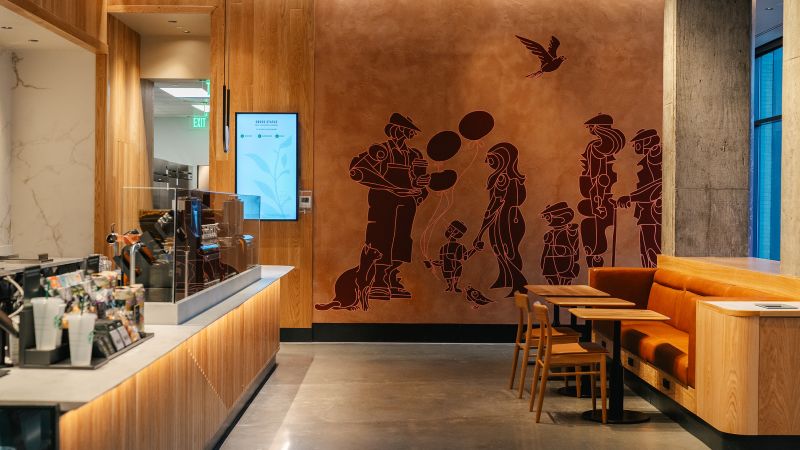Starbucks has opened its first cafe designed to give customers with disabilities a “more accessible store experience,” the company announced Friday in a news release.
The move is part of a wider inclusivity initiative that Starbucks has undertaken to design easily navigable retail spaces for all of its customers. Any cafe that is renovated or opened in the future will begin implementing the company’s “Inclusive Spaces Framework,” it said in the release.
Customers frequenting new stores will notice softer indoor lighting that “minimizes glare, shadow patterns and backlighting,” making it easier for people to read menu items or key in-store information, according to Starbucks. The store design will also take acoustics into account by using materials that minimize background noise or echoes, which could disrupt people who use hearing aids.
In recent years, a number of retailers have begun considering the shopping experiences of customers with different needs. This awareness was heightened, in part, by the COVID-19 pandemic. Confronted with social distancing guidelines, some retailers carved out specific blocs — typically early in the morning — when immunocompromised, elderly and disabled customers could do their shopping in a less crowded environment.
“The pandemic spurred a lot of retailers to think about more inclusive retail spaces,” said Maria Town, president and CEO of the American Association of People with Disabilities. “The growth of grocery delivery and pickup is also an element of inclusive retail, and I think more retailers have invested in these types of programs since the pandemic.”
More recently, some businesses have instated protocols and features that help reduce overstimulation and sensory overload. In November, Walmart began implementing “sensory-friendly” store hours between 8 and 10 in the morning, when in-store TV walls would feature a static image, music was turned off and store lights were dimmed. The retailer said these changes were an attempt to be more inclusive of customers and employees with sensory disabilities, including neurodiverse individuals.
In addition to paying attention to ambience, Starbucks said new stores will cut back on the front-of-house clutter with a new “continuous, unobstructed pedestrian path” that makes it easier for customers in wheelchairs or motorized scooters to get around the stores.
Counters where coffee and food is placed for pick-up will also be lowered to “accommodate wheelchair access and support better communication” between workers and customers, the company said.
Other changes include a new register that has a portable, adjustable stand, pictures of food and drink items, as well as voice assistance and screen magnification features.
According to the Centers for Disease Control and Prevention, one in four American adults has a disability, a term encompassing a wide spectrum of physical and mental experiences. Although the 1990 Americans with Disabilities Act codified nondiscrimination requirements for public-facing businesses in order to protect customers with disabilities, Town says non-compliance remains a pervasive issue in retail spaces.
“For retailers, basic compliance with ADA continues to be a struggle. Whether that’s wide enough pathways or actually making sure bathrooms are accessible and that disabled patrons can check out independently,” said Town. “There have been times where I have been shopping and I could not physically reach the card reader.”
Starbucks said its inclusivity framework will be “open sourced and further developed to help expand accessibility across the retail industry.” On its site, the company has a “Retail Checklist” available to download, which lays out a tiered plan for designing inclusive spaces “that elevates retail environments, beyond the ADA.”
“Starbucks opening of their new store built with inclusive design elements is a big moment as we try to make retail spaces more accessible and inclusive,” Tony Coelho, primary author and sponsor of the Americans with Disabilities Act, said in Starbucks’ release. “We have to go beyond just what is required to put accessibility and inclusion first to ensure all people feel like they belong in community spaces.”
The company has received criticism from disability rights activists in the past for eliminating plastic straws. But it reiterated its commitment to inclusivity this month, announcing a “goal to ensure that physical and digital Starbucks environments meet an elevated standard of accessibility by 2030.”
Starbucks added that it supports lawmaker efforts to expand and develop the ADA, such as eliminating a provision in the Act that allows employers to pay disabled workers less than minimum wage.
Town said it is encouraging to see Starbucks is looking at these issues in a systemic and policy-oriented way.
“What I think is so fantastic about these efforts is that they highlight a commitment to policies that help us create a more inclusive economy,” she said. “Even if we create retail spaces and experiences that are inclusive, it becomes less meaningful if there’s still bias and disability exclusion baked into our policies that prevent people with disabilities from having things like a disposable income.”
Starbucks (SBUX) said last month in its earnings call that it wants to open 4% more stores in the United States, where it currently has more than 16,000. The chain last unveiled a new store design in 2019 with much of the similar aesthetic approach left intact with the new look.
Read the full article here













Leave a Reply